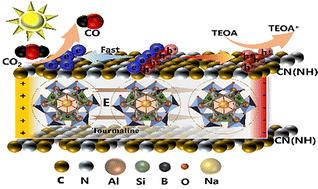当前位置:
X-MOL 学术
›
J. Mater. Chem. A
›
论文详情
Our official English website, www.x-mol.net, welcomes your
feedback! (Note: you will need to create a separate account there.)
Enhancing photoactivity of defective g-C3N4 via self-polarization effect of tourmaline for CO2 reduction
Journal of Materials Chemistry A ( IF 10.7 ) Pub Date : 2024-11-18 , DOI: 10.1039/d4ta06709f Jiangpeng Wang, Chao Huang, Deng Liu, HuiHui Peng, Qiong Luo, Dimin Yang, Xuelian Yu, Yingmo Hu
Journal of Materials Chemistry A ( IF 10.7 ) Pub Date : 2024-11-18 , DOI: 10.1039/d4ta06709f Jiangpeng Wang, Chao Huang, Deng Liu, HuiHui Peng, Qiong Luo, Dimin Yang, Xuelian Yu, Yingmo Hu

|
Graphite carbon nitride (g-C3N4) has been extensively studied as a non-metallic catalyst for photocatalytic reduction of CO2. However, its efficiency and selectivity in CO2 reduction still require further enhancement. In this study, we have incorporated the silicate mineral tourmaline, known for its spontaneous polarization properties, into g-C3N4 with nitrogen defects. The novel composite catalyst, named TM/CN(NH), was synthesized by a two-step method of high-temperature calcination. The optimal composite ratio of the sample (25TM/CN(NH)) can achieve a CO yield rate of 118.17 μmol g−1 h−1, which is 6.4 times that of the bulk g-C3N4(CN) and 2.9 times that of g-C3N4 containing N defects (CN(NH)). Our findings indicate that the self-polarization effect of tourmaline and the introduction of nitrogen vacancies can remarkably upgrade the photocatalytic efficiency of g-C3N4. On one hand, the nitrogen vacancies can broaden the light absorption range of g-C3N4, optimize its band gap structure, and improve its efficiency in utilizing light energy. On the other hand, the electric field generated by the self-polarization effect of tourmaline can enhance the migration of electrons in the lattice of g-C3N4, promote the migration and separation of electrons and holes, and thus increase the reduction efficiency of CO2 by g-C3N4. This research innovatively integrates cost-effective mineral materials into g-C3N4, significantly elevating the photocatalytic capabilities of g-C3N4. Furthermore, it paves the way for the rational design of abundant and inexpensive catalysts, aiming to achieve efficient photocatalytic carbon dioxide reduction.
中文翻译:

通过电气石的自极化效应增强缺陷 g-C3N4 的光活性以减少 CO2
石墨氮化碳 (g-C3N4) 作为光催化还原 CO2 的非金属催化剂已被广泛研究。然而,它在 CO2 还原中的效率和选择性仍需要进一步提高。在这项研究中,我们将以其自发极化特性而闻名的硅酸盐矿物碧玺掺入具有氮缺陷的 g-C3N4 中。采用高温煅烧两步法合成的新型复合催化剂,命名为TM/CN(NH)。样品的最佳复合比例 (25TM/CN(NH)) 可以达到 118.17 μmol g-1 h-1 的 CO 产率,是块体g-C 3N4(CN) 的 6.4 倍,是含有 N 缺陷 (CN(NH)) 的 g-C3N4 的 2.9 倍。我们的研究结果表明,电气石的自极化效应和氮空位的引入可以显着提高 g-C3N4 的光催化效率。一方面,氮空位可以拓宽 g-C3N4 的光吸收范围,优化其带隙结构,提高其利用光能的效率。 另一方面,电气石的自极化效应产生的电场可以增强电子在 g-C3N4 晶格中的迁移,促进电子和空穴的迁移和分离,从而提高 g-C3N4 对 CO2 的还原效率。这项研究创新性地将具有成本效益的矿物材料整合到 g-C3N4 中,显著提高了 g-C3N4 的光催化能力。此外,它为合理设计丰富且廉价的催化剂铺平了道路,旨在实现高效的光催化二氧化碳还原。
更新日期:2024-11-18
中文翻译:

通过电气石的自极化效应增强缺陷 g-C3N4 的光活性以减少 CO2
石墨氮化碳 (g-C3N4) 作为光催化还原 CO2 的非金属催化剂已被广泛研究。然而,它在 CO2 还原中的效率和选择性仍需要进一步提高。在这项研究中,我们将以其自发极化特性而闻名的硅酸盐矿物碧玺掺入具有氮缺陷的 g-C3N4 中。采用高温煅烧两步法合成的新型复合催化剂,命名为TM/CN(NH)。样品的最佳复合比例 (25TM/CN(NH)) 可以达到 118.17 μmol g-1 h-1 的 CO 产率,是块体g-C 3N4(CN) 的 6.4 倍,是含有 N 缺陷 (CN(NH)) 的 g-C3N4 的 2.9 倍。我们的研究结果表明,电气石的自极化效应和氮空位的引入可以显着提高 g-C3N4 的光催化效率。一方面,氮空位可以拓宽 g-C3N4 的光吸收范围,优化其带隙结构,提高其利用光能的效率。 另一方面,电气石的自极化效应产生的电场可以增强电子在 g-C3N4 晶格中的迁移,促进电子和空穴的迁移和分离,从而提高 g-C3N4 对 CO2 的还原效率。这项研究创新性地将具有成本效益的矿物材料整合到 g-C3N4 中,显著提高了 g-C3N4 的光催化能力。此外,它为合理设计丰富且廉价的催化剂铺平了道路,旨在实现高效的光催化二氧化碳还原。

































 京公网安备 11010802027423号
京公网安备 11010802027423号